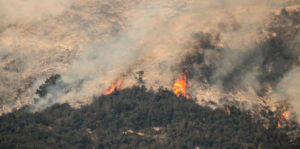 California’s Carr wildfire started on July 23, when a car malfunctioned on highway 299 in Whiskeytown. As of July 31, the fire has burned over 103,000 acres, destroyed over 966 structures, and claimed six lives. As of now, the fire covers over 110,000 acres–an area roughly the size of New Orleans. Over 3,300 firefighters are hard at work fighting the blaze and have contained 27% of it so far.
California’s Carr wildfire started on July 23, when a car malfunctioned on highway 299 in Whiskeytown. As of July 31, the fire has burned over 103,000 acres, destroyed over 966 structures, and claimed six lives. As of now, the fire covers over 110,000 acres–an area roughly the size of New Orleans. Over 3,300 firefighters are hard at work fighting the blaze and have contained 27% of it so far.
The Carr fire is only one of over a dozen wildfires blazing over the state of California right now. Devastating wildfires like these have a significant and lasting impact on California’s natural ecosystem. In particular, all Californian’s should be aware of how wildfires can affect our state’s water and air quality. Here’s what you should know about the consequences of wildfires, and how you can account for them in your life.
Water
 How Wildfires Affect It
How Wildfires Affect It
Did you know that more than half of the Southwest US water supply comes from forest water? Almost 80 percent of the freshwater resources in the US originate on forested land. When those forests burn, it can seriously affect the whole region’s drinking water. During forest fires, ash and other debris can collect in reservoirs and introduce waterborne contaminants. Ironically, wildfires may pose an even greater risk to water supplies after they’re extinguished.
Wildfires, especially large ones like the Carr, often burn so hot that they severely burn the soil around them. Burned soil can’t absorb water very effectively. When it rains in burned forest area, the burned soil erodes or becomes mud instead of absorbing the water. When the soil erodes, the minerals and contaminants inside it are absorbed into water sources downstream. Contaminants introduced into water supplies by runoff from burned soil can affect water for years.
How You Can Adapt
It’s never a bad idea to pay attention to local water quality reports. The USGS monitors the quality and sediment characteristics of water affected by fires. You should also pay attention to area weather reporting. Expect some water quality issues immediately following rainstorms, especially if it storms in areas affected by wildfire. You could even figure out where your drinking water is coming from to find out if you’re at-risk after a rainstorm or fire.
The same, traditional ways you can try to clean your water will help with wildfire-related risks, as well. Many homeowners install water filters in their home. These filters aren’t a guaranteed solution, but they can help block wildfire-related contaminants that other treatments may miss. There are two types of filter: whole-home and point of entry. Whole-home filters hook up to your water main directly, while point-of-entry filters fit onto individual fixtures.
Air
 How Wildfires Affect It
How Wildfires Affect It
According to the National Oceanic & Atmospheric Administration, wildfires emit “substantial amounts of volatile and semi-volatile materials and nitrogen oxides that form ozone and organic particulate matter.” These particulates can hang in the air for long periods of time and substantially lower air quality. Smoke from wildfires can travel hundreds of miles from its original source depending on wind conditions, carrying particulates with it. Even short-term exposure to wildfire smoke can lead to asthma attacks, inflammation, and cardiovascular and neurological issues.
Unfortunately, wildfires have long-term negative health effects on air quality, too. The airborne and gaseous particles wildfires release (carbon monoxide, nitrogen dioxide, formaldehyde, acetaldehyde) can disperse over hundreds of miles. Some studies concluded that wildfires burning within 50-100 miles of a city caused air quality to be 5-15 times worse than normal. Air quality drops triggered by wildfires can be particularly bad in parts of California that are situated in valleys–like LA.
How You Can Adapt
First, pay particularly close attention to your local air quality reports, especially during wildfire season. Follow the directions suggested by these reports. On high-risk days, avoid spending too much time outside. Closing your windows and running your AC won’t totally eliminate risk, but it does help. Close your AC unit’s fresh air intake to prevent outdoor air from coming inside. Make sure you replace your AC’s air filter frequently, especially during wildfire season. Check the filter bi-weekly. If it looks dirty, clean or replace it right away.
There are several kinds of air cleaners, and some are far more effective than others. We recommend using the California Air Resources Board’s Air Cleaner information to inform your choice. The EPA also collects helpful information here. Remember, however, that even an effective air cleaner can’t solve all air quality problems on its own. Maximize air quality protection by keeping a clean home, refraining from producing other airborne pollutants, and using a filtered HVAC system.
Unfortunately, wildfires are only becoming more frequent in California and the rest of the Southwest US. Fire season lasts longer, the fires burn longer and hotter, and they’re starting more easily. Dealing with wildfires is only going to become an even more crucial part of living in California.
Luckily, none of us are in it alone. If you have questions about your water or air quality, you can give Mike Diamond a call any time. Our experts are ready to answer your questions and make sure you have everything you need to stay safe.


